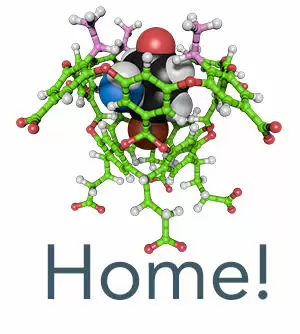The synthesis of three different nanoscale molecular hosts is reported. These cavitands each possess a highly preorganized cavity with an open portal (nearly 1 nm wide), by which guests can enter and egress the cavity. Additionally, these hosts are deep-functionalized with a crown of weakly acidic benzal C--H groups which can form a variety of noncovalent interactions with guest molecules residing within the cavity. Thirty-one guests were examined for their propensity to form complexes with the hosts. Guests that possess halogen atoms were the strongest binders, suggesting the formation of polydentate C--H⋅⋅⋅X--R hydrogen bonds with the deep crown of benzal hydrogens. Exchange rates between the free and bound states were noted to be dependent on the size of the guest and the solvent used to study complexation. In general, stronger binding and slower exchange were noted for complexations carried out in DMSO with highly complementary guests. The orientation of each guest within the cavity was determined using either EXSY NMR spectroscopy or 1H NMR shift data. Cumulatively these results showed that the principal factors directing orientation were interactions with the benzal groups and the type of solvent. Van't Hoff analyses of selected complexations were also carried out. As well as revealing that all complexations were entropically unfavorable, these experiments provided support for guest orientation determinations, and gave an estimation that the formation of a C--H⋅⋅⋅I--R hydrogen bond releases between 1 and 1.5 kcal mol−1.
Publications by Year: 2003
2003
Laughrey, Z. R.; Gibb, C.; Senechal, T.; Gibb, B. C. Guest Binding and Orientation within Open Nanoscale Hosts. Chemistry – A European Journal 2003, 9, 130-139.
Li, X.; Upton, T. G.; Gibb, C.; Gibb, B. C. Resorcinarenes as Templates: A General Strategy for the Synthesis of Large Macrocycles. Journal of the American Chemical Society 2003, 125, 650-651.
Gibb, B. C. Resorcinarenes as Templates. Chemistry – A European Journal 2003, 9, 5180-5187.
Abstract Metal ions are superb at templating the synthesis of small macrocycles that are decorated with Lewis basic sites. However, for the synthesis of larger macrocycles, or the synthesis of macrocycles devoid of an array of Lewis basic sites, metal ions are less useful. Here we demonstrate that resorcinarenes can be used as templates to engender the efficient formation of large crown ethers. A three step process of 1) tethering moieties to the template, 2) linking those moieties, and 3) then cleaving off the template leads to the efficient formation of a family of aromatic crown ethers. If adaptable, this approach will prove useful for the construction of macrocycles that are hard to obtain from a step-wise synthesis.

